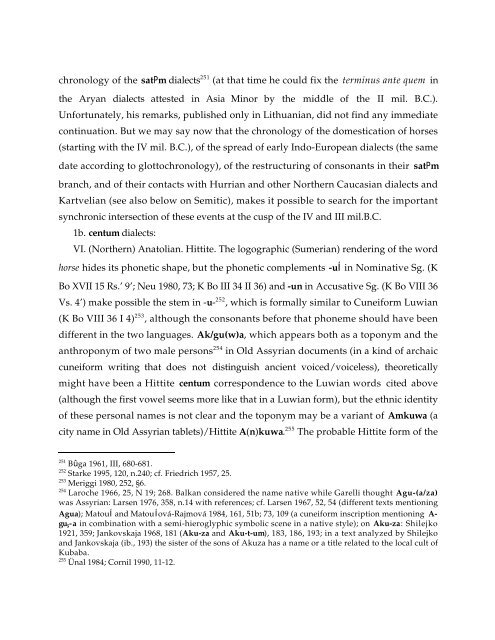Comparative Notes on Hurro-Urartian, Northern Caucasian
Comparative Notes on Hurro-Urartian, Northern Caucasian
Comparative Notes on Hurro-Urartian, Northern Caucasian
You also want an ePaper? Increase the reach of your titles
YUMPU automatically turns print PDFs into web optimized ePapers that Google loves.
chr<strong>on</strong>ology of the satPm dialects 251 (at that time he could fix the terminus ante quem in<br />
the Aryan dialects attested in Asia Minor by the middle of the II mil. B.C.).<br />
Unfortunately, his remarks, published <strong>on</strong>ly in Lithuanian, did not find any immediate<br />
c<strong>on</strong>tinuati<strong>on</strong>. But we may say now that the chr<strong>on</strong>ology of the domesticati<strong>on</strong> of horses<br />
(starting with the IV mil. B.C.), of the spread of early Indo-European dialects (the same<br />
date according to glottochr<strong>on</strong>ology), of the restructuring of c<strong>on</strong>s<strong>on</strong>ants in their satPm<br />
branch, and of their c<strong>on</strong>tacts with Hurrian and other <strong>Northern</strong> <strong>Caucasian</strong> dialects and<br />
Kartvelian (see also below <strong>on</strong> Semitic), makes it possible to search for the important<br />
synchr<strong>on</strong>ic intersecti<strong>on</strong> of these events at the cusp of the IV and III mil.B.C.<br />
1b. centum dialects:<br />
VI. (<strong>Northern</strong>) Anatolian. Hittite. The logographic (Sumerian) rendering of the word<br />
horse hides its ph<strong>on</strong>etic shape, but the ph<strong>on</strong>etic complements -uÍ in Nominative Sg. (K<br />
Bo XVII 15 Rs.’ 9’; Neu 1980, 73; K Bo III 34 II 36) and -un in Accusative Sg. (K Bo VIII 36<br />
Vs. 4’) make possible the stem in -u- 252 , which is formally similar to Cuneiform Luwian<br />
(K Bo VIII 36 I 4) 253 , although the c<strong>on</strong>s<strong>on</strong>ants before that ph<strong>on</strong>eme should have been<br />
different in the two languages. Ak/gu(w)a, which appears both as a top<strong>on</strong>ym and the<br />
anthrop<strong>on</strong>ym of two male pers<strong>on</strong>s 254 in Old Assyrian documents (in a kind of archaic<br />
cuneiform writing that does not distinguish ancient voiced/voiceless), theoretically<br />
might have been a Hittite centum corresp<strong>on</strong>dence to the Luwian words cited above<br />
(although the first vowel seems more like that in a Luwian form), but the ethnic identity<br />
of these pers<strong>on</strong>al names is not clear and the top<strong>on</strong>ym may be a variant of Amkuwa (a<br />
city name in Old Assyrian tablets)/Hittite A(n)kuwa. 255 The probable Hittite form of the<br />
251 Bûga 1961, III, 680-681.<br />
252 Starke 1995, 120, n.240; cf. Friedrich 1957, 25.<br />
253 Meriggi 1980, 252, §6.<br />
254 Laroche 1966, 25, N 19; 268. Balkan c<strong>on</strong>sidered the name native while Garelli thought Agu-(a/za)<br />
was Assyrian: Larsen 1976, 358, n.14 with references; cf. Larsen 1967, 52, 54 (different texts menti<strong>on</strong>ing<br />
Agua); MatouÍ and MatouÍová-Rajmová 1984, 161, 51b; 73, 109 (a cuneiform inscripti<strong>on</strong> menti<strong>on</strong>ing Agu<br />
5-a in combinati<strong>on</strong> with a semi-hieroglyphic symbolic scene in a native style); <strong>on</strong> Aku-za: Shilejko<br />
1921, 359; Jankovskaja 1968, 181 (Aku-za and Aku-t-um), 183, 186, 193; in a text analyzed by Shilejko<br />
and Jankovskaja (ib., 193) the sister of the s<strong>on</strong>s of Akuza has a name or a title related to the local cult of<br />
Kubaba.<br />
255 Ünal 1984; Cornil 1990, 11-12.





